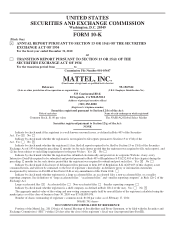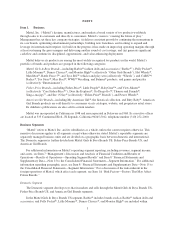Mattel 2010 Annual Report Download - page 14
Download and view the complete annual report
Please find page 14 of the 2010 Mattel annual report below. You can navigate through the pages in the report by either clicking on the pages listed below, or by using the keyword search tool below to find specific information within the annual report.Competition and Industry Background
Competition in the manufacture, marketing, and sale of toys is based primarily on quality, play value, and
price. Mattel offers a diverse range of products for children of all ages and families that include, among others,
toys for infants and preschoolers, girls’ toys, boys’ toys, youth electronics, hand-held and other games, puzzles,
educational toys, media-driven products, and fashion-related toys. The Mattel Girls & Boys Brands US and
Fisher-Price Brands US segments compete with several large toy companies, including Bandai, Hasbro, Jakks
Pacific, Leap Frog, Lego, Spin Master, MGA Entertainment, and VTech, many smaller toy companies, and
several manufacturers of video games and consumer electronics. American Girl Brands competes with
companies that manufacture girls’ toys and with children’s book publishers and retailers. Mattel’s International
segment competes with global toy companies including Bandai, Hasbro, Lego, MGA Entertainment, Playmobile,
and VTech, other national and regional toy companies, and manufacturers of video games and consumer
electronics. Foreign regions may include competitors that are strong in a particular toy line or geographical area,
but do not compete with Mattel or other international toy companies worldwide.
Competition among the above companies is intensifying due to recent trends towards shorter life cycles for
individual toy products, the phenomenon of children outgrowing toys at younger ages, and an increasing use of
high technology in toys. In addition, a small number of retailers account for a large portion of all toy sales,
control the shelf space from which toys are viewed, and have direct contact with parents and children through
in-store purchases, coupons, and print advertisements. Such retailers can and do promote their own private-label
toys, facilitate the sale of competitors’ toys, and allocate shelf space to one type of toys over another.
Seasonality
Mattel’s business is highly seasonal, with consumers making a large percentage of all toy purchases during
the traditional holiday season. A significant portion of Mattel’s customers’ purchasing occurs in the third and
fourth quarters of Mattel’s fiscal year in anticipation of such holiday buying. These seasonal purchasing patterns
and requisite production lead times create risk to Mattel’s business associated with the underproduction of
popular toys and the overproduction of less popular toys that do not match consumer demand. Retailers are also
attempting to manage their inventories more tightly in recent years, requiring Mattel to ship products closer to the
time the retailers expect to sell the products to consumers. These factors increase the risk that Mattel may not be
able to meet demand for certain products at peak demand times or that Mattel’s own inventory levels may be
adversely impacted by the need to pre-build products before orders are placed. Additionally, as retailers manage
their inventories, Mattel experiences cyclical ordering patterns for products and product lines that may cause its
sales to vary significantly from period to period.
In anticipation of retail sales in the traditional holiday season, Mattel significantly increases its production
in advance of the peak selling period, resulting in a corresponding build-up of inventory levels in the first three
quarters of its fiscal year. Seasonal shipping patterns result in significant peaks in the third and fourth quarters in
the respective levels of inventories and accounts receivable, which result in seasonal working capital financing
requirements. See Item 8 “Financial Statements and Supplementary Data—Note 7 to the Consolidated Financial
Statements—Seasonal Financing and Debt.”
Product Design and Development
Through its product design and development group, Mattel regularly refreshes, redesigns, and extends
existing toy product lines and develops innovative new toy product lines for all segments. Mattel believes its
success is dependent on its ability to continue this activity effectively. See Item 1A “Risk Factors—Factors That
May Affect Future Results.” Product design and development activities are principally conducted by a group of
professional designers and engineers employed by Mattel. During 2010, 2009, and 2008, Mattel incurred
expenses of $173.9 million, $171.3 million, and $190.2 million, respectively, in connection with the design and
development of products, exclusive of royalty payments. See Item 8 “Financial Statements and Supplementary
Data—Note 16 to the Consolidated Financial Statements—Supplemental Financial Information.”
6
























